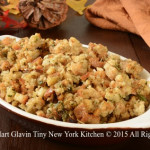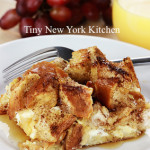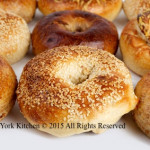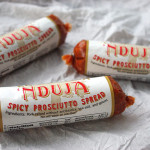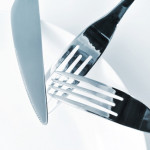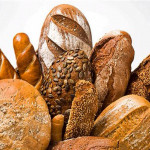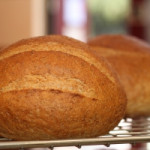Dressing & Stuffing
I get asked this question every year about this time, “what’s the difference between dressing and stuffing?” The answer is that if you live north of the Mason-Dixon line, you probably call this side dish, baked inside a turkey, stuffing. If you’re a Southerner, you probably call it dressing. In classic cooking, it’s called forcemeat. Until Victorian times it was just called stuffing and then all of a sudden “stuffing” seemed indecent, and “dressing” was the new name.
For many years roast turkey meant stuffed turkey. Then all of a sudden health concerns arose about whether or not stuffed birds were safe. While these concerns are real, they shouldn’t affect careful cooks who follow food safety practices. Here are a few simple rules to follow while stuffing your bird.
Stuffing should always be cooked to at least 160 degrees in order to kill any potentially harmful bacteria. When the turkey is done, insert the meat thermometer deep into the center of the body cavity to check the temperature of the stuffing. If it isn’t at least 160 degrees then scoop the stuffing out of the cavity and transfer to a casserole dish. Cover and bake at 350 degrees until the stuffing reaches 160 degrees.
Always prepare your stuffing just before filling and roasting the turkey. NEVER stuff a bird the night before roasting as the turkey cavity provides a warm, moist environment that encourages bacterial growth. To save time on Thanksgiving morning, you can prepare stuffing ingredients the night before. Chop the vegetables, toast the nuts, etc. and then store them in zip lock bags in the refrigerator. If you are super pressed for time you may cook, cool, and refrigerate the seasoning meat and vegetables the night before. Reheat them thoroughly in a large-size skillet before adding to the bread or grains.
Stuffing should be warm when placed in the turkey. Cold stuffing may not cook to 160 degrees by the time the turkey is ready.
NEVER mix raw meat or vegetables into a stuffing. All meat and vegetables should be thoroughly cooked.
To serve the stuffing, remove it from the turkey and place in a serving bowl. Do not allow the stuffing or turkey to stand at room temperature for longer than 2 hours. Refrigerate any leftover stuffing separately from the turkey and use within 2 days. Reheat leftover stuffing thoroughly before serving.
“Work With What You Got!”
© Victoria Hart Glavin Tiny New York Kitchen © 2015 All Rights Reserved
I woke up late and decided that it was a good day for French Toast with sliced pears. Every bite was delicious.
“Work With What You Got!”
© Victoria Hart Glavin Tiny New York Kitchen © 2015 All Rights Reserved
Who doesn’t love a good bagel? Suddenly, the Upper West Side has become a magnet for baked goods. The first branch of Orwashers, the Upper East Side bakery that turns 100 next year, will open in December in a space where it will bake on the premises. Not counting a kiosk in Bryant Park, Breads Bakery will open its second store in October, this one near Lincoln Center. And the H & H Bagels name will return to the neighborhood this winter. The new bakery is a branch of H & H Midtown Bagels East, the spinoff from the original, which was on Broadway. Now there’s a reason to move back to the West Side!
Orwashers: 440 Amsterdam Avenue
Breads Bakery: 1890 Broadway
H & H Midtown Bagels East: 526 Columbus Avenue
“Work With What You Got!”
© Victoria Hart Glavin Tiny New York Kitchen © 2015 All Rights Reserved
Spreadable sausage from Norwalk, Iowa? The culinary creativity across the country never ceases to amaze me. Nduja is a spreadable sausage that comes from Calabria in southern Italy. My husband is Calabrian so it goes without saying that I love all things from Calabria. La Quercia, the cured meat producer in Iowa has introduced its American-made version, which is a mix of prosciutto, speck, and red chili peppers. It comes in five ounce links and is extremely versatile. Use it in pasta sauce, grilled cheese, BLTs, egg salad, burgers, pizza, crostini, or tacos. It’s also wonderful slathered on warm bread or crackers.
If you’re in New York City you may find it at Fairway, Amish Market, or Murray’s Cheese. If you’re in other parts of the country then go to La Quercia’s website for store locations. http://laquercia.us
“Work With What You Got!”
© Victoria Hart Glavin Tiny New York Kitchen
Perplexing Foodstuffs
There are those foods that can be rather difficult to figure out how to eat without looking like you were born in a cave. Here are some useful tips for properly eating perplexing foodstuffs.
Artichokes
Pluck off artichoke leaves and scrape the tender part (not the prickly point) between your teeth (preferably after dipping in melted butter). Work your way to the delicate inner leaves, and then use a knife to cut off the remaining small leaves and feathery innards. Cut the artichoke “heart” into bite-sized pieces and eat with a fork.
Asparagus
Eat asparagus with your fingers if served raw as crudités. Eat with a fork and knife if served with dinner.
Bread
Break bread into bite-sized pieces, and butter it or dip it into olive oil just one piece at a time.
Crab (Soft-Shelled)
Eat entire crab, including shell, either in sandwich form or using a fork and knife. Remove inedible pieces from your mouth with a fork.
Fajitas
Place meats, vegetables, and other fillings on a flat tortilla. Roll up and use your fingers to eat fajitas from one end.
Fondue
Spear bread, vegetables, or fruit with a fondue spear and dip into cheese or sauce. Remove food from spear using a dinner fork, and eat from a plate. DO NOT double dip. Spear uncooked meat cubes and place spear into fondue broth or sauce. When cooked, transfer meat to a plate using a dinner fork and cut into smaller pieces to eat.
Lobster
Wear a lobster bib to avoid fishy splatters, Crack shells with shellfish crackers and extract meat with a small fork or pick. Cut larger pieces with a knife, and eat with a fork after dipping in melted butter. Clean your hands by dipping fingers into finger bowls, and use lemon (if provided) to cut extra grease. Dry your hands with your napkin.
Peas
Use a knife to push peas onto a fork. Do not mash peas before eating, or eat peas from a knife.
Raw Shellfish
Use a small fork to extract mussels, clams, or oysters from the half-shell. Season with fresh lemon or cocktail sauce. In informal settings, you may quietly slurp shellfish from shells.
Soup
Using a soup spoon, spoon soup away from your body and then quietly sip from side of spoon. Tilt bowl away from you to spoon up remaining drops.
Spaghetti
Twirl pasta with fork tines into bite-sized portions, and allow any dangling pieces to fall back onto your fork. You may also rest fork tines against the bowl of a spoon while you twirl pasta.
Steamers
Extract clam from shell using a small fork, and use a fork and knife to remove inedible neck. In informal settings, it is permissible to use fingers.
“Work With What You Got!”
© Victoria Hart Glavin Tiny New York Kitchen
Table Manners Dos and Don’ts
I believe it’s always best to start with the positive so let’s start with the “Dos.”
Table Dos
Do place your napkin in your lap, and use it to blot your lips and wipe your hands.
Do wait for your hostess to be seated before you start eating, unless requested to do so earlier.
Do cut food into manageable, bite-sized pieces, and swallow before you speak.
Do say, “Please pass the…” instead of reaching across the table and igniting yourself on an open flame.
Do place fork and knife diagonally across the upper right hand corner of your plate when you are finished eating.
Do remove hot or inedible substances from your mouth with your fork, not your fingers or napkin.
Do eat drink garnishes after draining your glass, not before.
Do use a fork when sopping up gravy or sauces with chunks of bread.
Do use finger bowls to clean fingers, and hot towels to clean hands and mouths.
Do refrain from making or receiving phone calls at the table.
Table Don’ts
Don’t grasp eating utensils as you would a garden trowel or hammer, or place used utensils directly on the table.
Don’t tuck your napkin into your shirt collar.
Don’t primp or clean your teeth at the table.
Don’t fidget or make loud noises while you eat (slurping, burping, lip-smacking).
Don’t slouch or otherwise lean on the table.
Don’t scoop ice from your water glass to cool hot soups or beverages.
Don’t season your food before you taste it.
Don’t push your plate away from you when you are finished eating.
Don’t leave your spoon in your mug while drinking from it, or wring tea bags with your fingers.
Don’t dunk donuts or scones into beverages.
“Work With What You Got!”
© Victoria Hart Glavin Tiny New York Kitchen
When you have only two pennies left in the world, buy a loaf of bread with one, and a lily with the other. – Chinese Proverb
Bread: Legend And Lore
Bread – “The Symbol of Friendship & Hospitality.” In ancient times many cultures believed bread was a Gift from God. Live a good life and “Break Bread With Friends!
English – “Bread is the Staff of Life.”
Russian – “Bread is the symbol of friendship.”
Spanish – “All sorrows are less with bread.”
Italian – “Bread is all food, the rest is merely accompaniment.”
German – “Bread is the symbol of home and family.”
French Saying – “As good as bread.”
Danish – “Bread is better than the song of the birds.”
American Indians danced the “Bread Dance” for prosperity and good crops.
Slavic Proverb – “Without bread even a palace is sad, but with it a Pine Tree is Paradise.”
© Victoria Hart Glavin
 Constitution Week – Foods of Our Forefathers Part III
Constitution Week – Foods of Our Forefathers Part III
The abundance of meat in America was a major change in the diet of the early settlers. Rabbits and squirrels were available year-round nearly everywhere, plus deer and other large game in many regions. As settlers moved west, buffalo gained importance in the diet. Fish, shellfish and wild fowl became common food, and they were all essentially “free.” The existence of these various forms of game was a literal life saver in times of uncertain crops and unbroken land. The game gradually diminished, of course, as the population expanded and settlers pushed west, but it provided a large share of the diet in early and frontier days.
Ham, of course, appeared on almost every settler’s table, rich or poor. It might be the only meat served at a meal or it might appear in company with more exotic roasts and fowl, but it was always there – breakfast, dinner and supper.
Corn was also a staple of the colonists, either fresh in summer, or as hominy or corn meal all year. Corn was also put to another use by an early Virginian, Captain George Thorpe, who may have been the first food technologist in America as he invented Bourbon whiskey shortly before he was massacred by the Indians in 1622.
Meal patterns for working people in rural early America were very different from those common today. Breakfast was usually early and light which consisted of bread, hominy grits, and sometimes fruit in season. Coffee, which was a new beverage at the time, was popular that is if it was available. A drink made from caramelized grain was sometimes substituted. Chicory was popular in the South, either alone or used to stretch the coffee. Tea was often made from local leaves such as sage, raspberry or dittany. Alcohol in some form was often served.
Breakfast in more elegant homes or large plantations might be later in the morning, and include thinly sliced roast and ham.
Dinner was served somewhere between midday and midafternoon, depending on the family’s circumstances, and was the big meal of the day. There was almost always ham, as well as greens (called sallat), cabbage and other vegetables. In the proper season, special dainties would appear – fresh fruits and berries, or fresh meat at appropriate butchering times.
Desserts could be simple such as a scooped out pumpkin, baked until done and then filled with milk, to be eaten right out of the shell. Or dessert could be more complex such as ice cream or other fruit flavored frozen pudding or a blanc mange. Blanc mange was prepared from milk and loaf sugar, flavored with a tablespoon or two of rosewater, thickened with a solution of isinglass (derived from fish bladder, soaked overnight in boiling water). This mixture was boiled for 15 to 20 minutes, then poured into molds to set.
If isinglass was not available (most was imported from England), homemade calves foot jelly could be substituted, but eh dessert was not as fine.
Various alcoholic beverages, including wines, applejack, “perry” (hard cider made from pears), or beer were commonly consumed.
In winter, peaches and other fruit disappeared from the dinner table, to be replaced by dishes made from stored apples and dried fruit of various sorts. Soups or broths also took their place. Milk grew scarce as cows “dried up” in the short days. Vegetables gradually decreased in variety as stored crops wilted.
Apples quickly became a staple in early America. Orchards were easy to start, required a minimum of care, and apples stored well. Housewives devised a multitude of “receipts,” including sauces and butters for off-season, as well as many using dried apples.
Supper was late and a light bread and butter, some of the left-over roast from dinner, fruit (fresh if in season, pickled and spiced otherwise), and coffee or tea.
To Be Continued…

